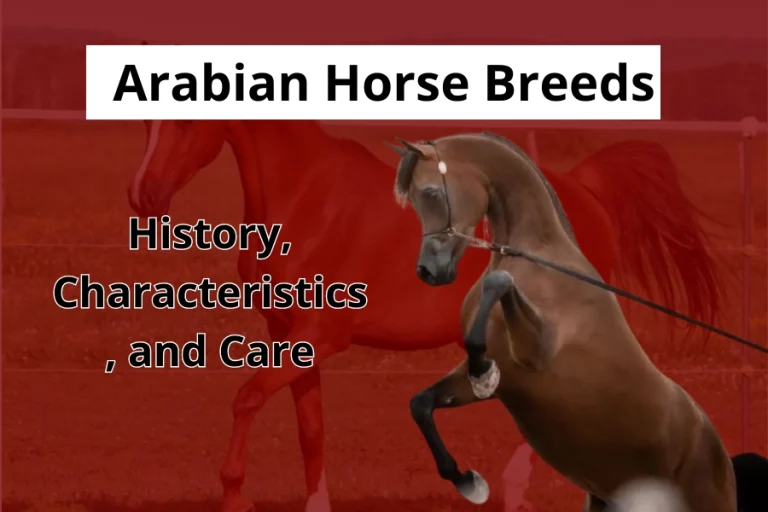Gorgeous Friesian Horse Breeds: All You Need To Know
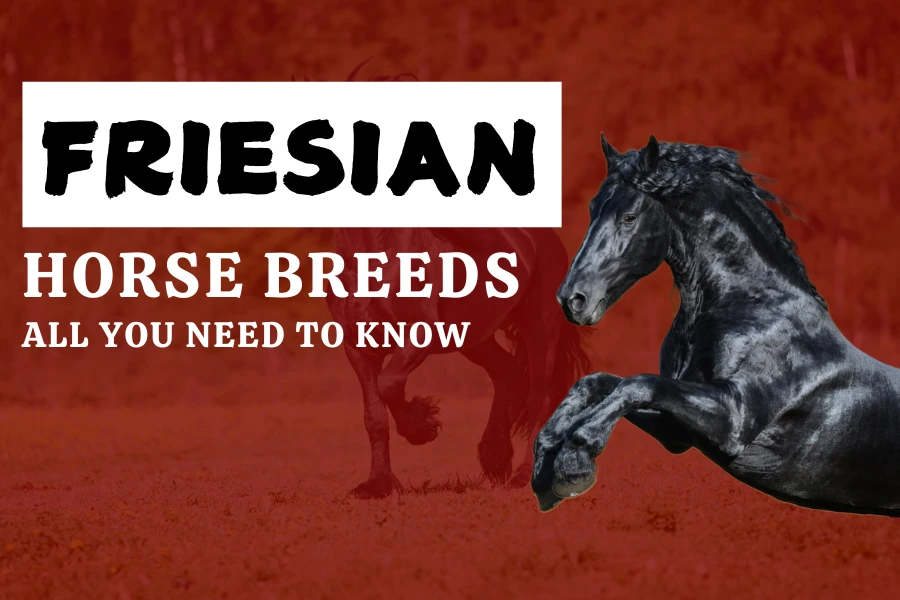
With stunning black coats, long manes, and feathered legs, Friesian horse breeds have captured the admiration of horse lovers around the world. This is one of the oldest and most well-known horse breeds in Europe, with its roots in the Friesland region of the Netherlands. Nowadays, they are sought after greatly for a wide range of equestrian purposes, like dressage or carriage driving.
In this article, we will provide insight into the fascinating world of the Friesian Horse breed. You will learn about their history, characteristics, disciplines, and other related.
Friesian Horse Breeds History & Origin
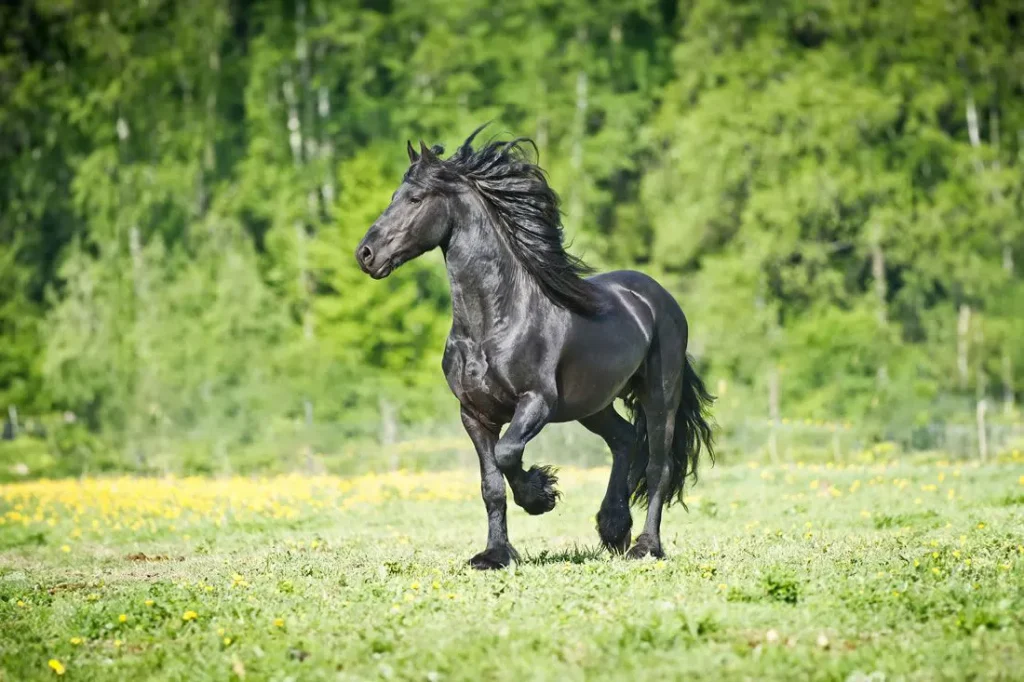
The Friesian Horse breeds are very old and their existence was traced back well over the year thousand years. Originally bred in the area of Friesland in the Netherlands. Therefore Friesian can be considered one of the oldest horse breeds in Europe.
The predecessors of the contemporary Friesian Horse originated far as in the Middle Ages, where they were primarily used for warfare. These animals were considered powerful, fast, and stately. That is why they were preferred for taking knights and other soldiers with heavy armor to the battlefield.
In around the 16th and 17th centuries, when the Netherlands was beneath the mastery of Spain, Andalusian blood was presented into the Friesian breed. This helped shape the modern Friesian’s distinctive high-stepping gait and majestic presence.
The Fox Friesians
In a unique chapter of Friesian horse history, some foals were born with unexpected red coats. Then, they earned the charming nickname “Fox Friesians.” This occurred when both the dam and sire carried a recessive red gene. While these red-coated Friesians were quite endearing, breeders aimed to preserve the breed’s signature black coat.
To achieve this, DNA testing was introduced into the breeding process. The test taken ensures that future generations maintain the traditional black coats of the Friesian horse breeds.
Characteristics of Friesian Horse Breeds
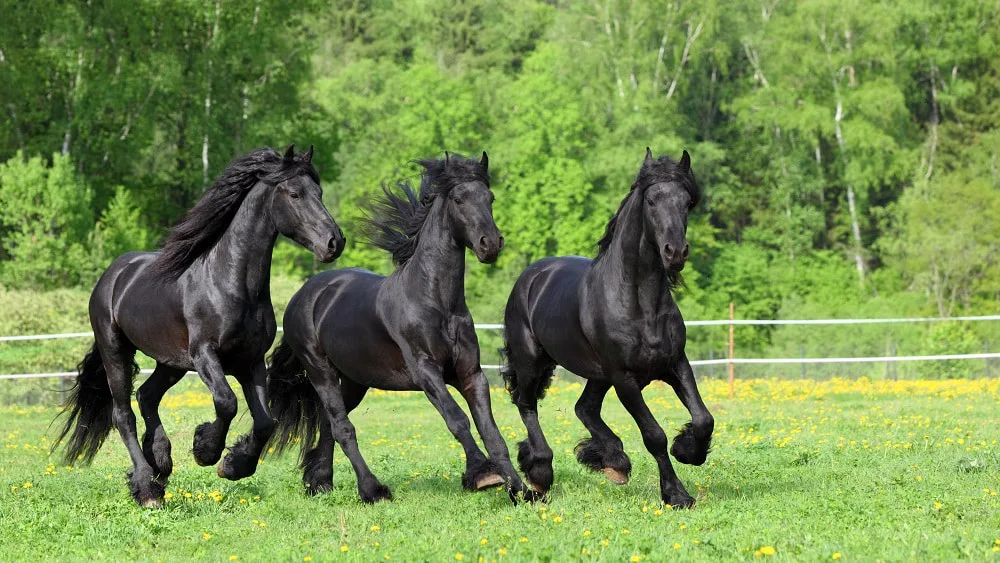
Known and appreciated for proud conformation, striking colors, and a friendly disposition, here is a detailed look at these characteristics in the Friesian Horse.
Appearance
- Physique: They usually range from 15.2 to 17 hands high, equivalent to about 62 to 68 inches in height. Their body is well-muscled, with a deep chest, a strong, arched neck, and a muscular, compact frame.
One of the most striking highlights approximately a Friesian is its long, streaming mane and tail, which are regularly wavy and truly include the dramatization in their appearance. Besides, these beautiful horse breeds have feathers running down their lower legs. All these features put together give them a really elegant and regal look.
- Head: A Friesian horse carries his head high, with very expressive eyes and small, alert ears that curve slightly in at the tips.
- Movement: Friesians are a breed very recognizable due to their high-leg lift trot, which is both graceful and powerful. Their movements are flowing and full of energy. Therefore, they excel in dressage and most other equestrian sports.
Colors
Black seems to be the most symbolic color for a Friesian horse. Typically, they have deep and glossy black coats. Although black is the predominant color, there may be some Friesians in colors like dark bay or chestnut. However, such are very rare and most breed standards just do not accept them for registration.
Temperament
These beautiful black horses are a breed of quiet disposition and mild character. Friendly and willing, with the desire to please, they are excellent companions and versatile performers of many equestrian modalities.
Trainability
Their intelligence and their desire to please make them quite easy to train. With their responsive attitude, this breed does very well in dressage, driving, and pleasure riding. They pick up quickly and have become a very popular breed not only in competing sports but also in recreational and therapeutic riding.
Friesian Horses & Disciplines
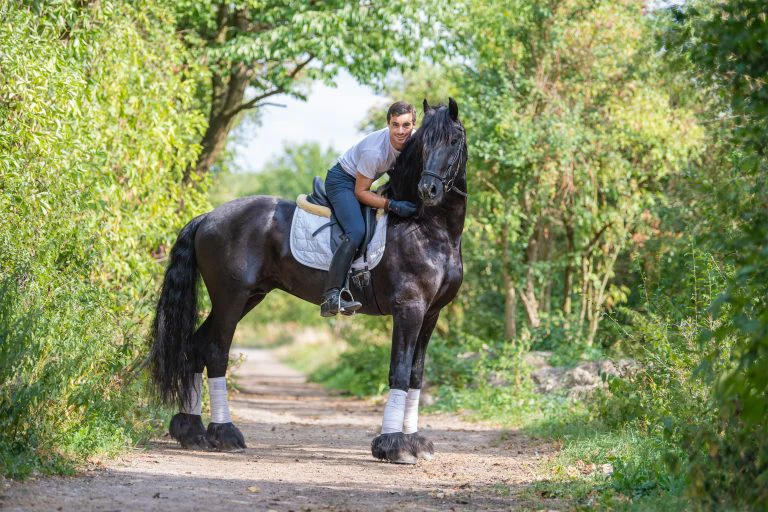
We not only love Friesian horses for their beauty and elegance but also their versatility in a wide range of activities, from classical dressage to modern sports and leisure riding.
- Dressage: They are highly valued in this specific area because they naturally possess grace, a high-stepping trot, and a willingness to execute. In the case of Dressage competitions, fine presence, and limb movements set them off.
- Driving: The power, endurance, and striking appearance of the Friesian have made them a natural fit for driving. In the past, they were used as carriage horses and excelled in both single and team-driving events.
- Pleasure Riding: The gentle nature and most pleasant riding style of the Friesian make it a favorite among pleasure riders. They are suitable for all riders, beginning to experience.
- Therapeutic Riding: It is often that the Friesians are used for equine-assisted therapy. This is because of the close bond they have with riders and the feeling of safety and trust they instill.
Health Of Friesian Horses
The Friesian horses have also been found to be prone to some health problems. These may affect the longevity and quality of life of a horse and, as such, call for good management by the owner. Friesians only live between 16 to 20 years, compared to the average horse’s 30-year lifespan.
- Dwarfism: This is a genetic fault in Friesians that causes the limbs to grow shorter than usual, among other associated anomalies in growth. The afflicted horse can have numerous skeletal deformities, resulting in pain and a poor gait.
- Aortic Rupture: This is an important cause of sudden death in Friesians. The aorta is the largest artery in the body, and when it ruptures, it will cause massive internal bleeding.
- Megaesophagus: This is a disorder in which the esophagus dilates, loses its peristalsis, and is unable to move food appropriately down to the stomach. Regurgitation takes after, which can lead to weight misfortune and desire pneumonia.
- Retained Placenta: In Friesian female horses, there is a higher rate of held placenta after foaling. This can be associated with serious complications. Thus, early veterinary intervention is essential for its effective management and treatment.
Feeding Friesian Horses
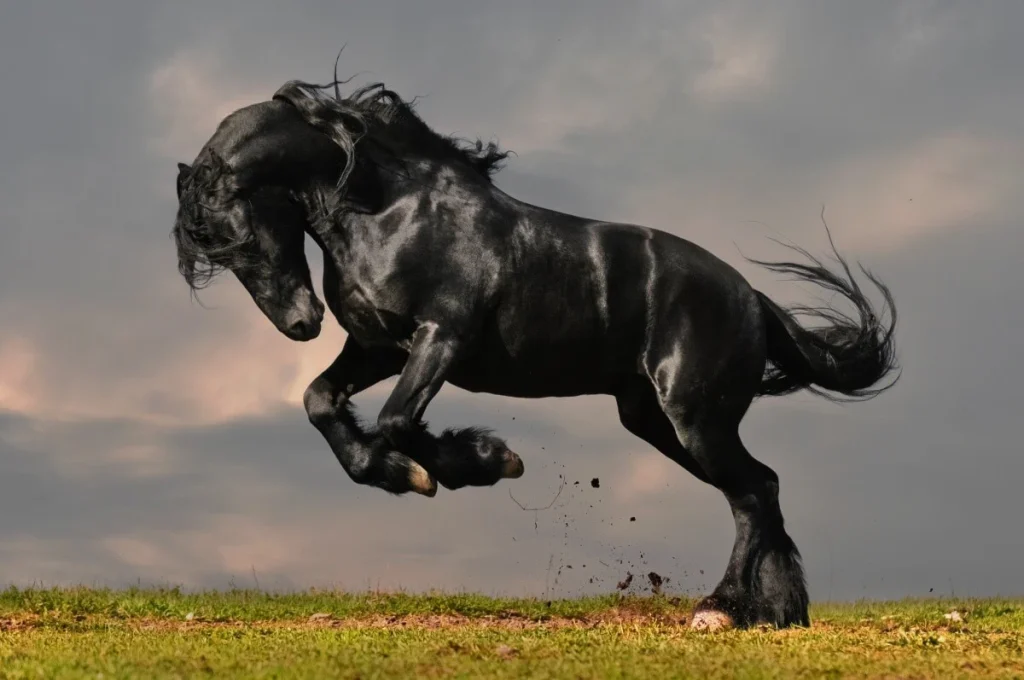
Since the health and performance of the Friesian horse are so closely linked, proper nutrition is essential. Below is the ultimate guide to adequate dietary intake for their particular needs.
General Dietary Requirements
Forage
- Primary Component: High-quality hay or pasture grass needs to consist of the bulk of a Friesian’s diet. This interprets to everyday intake of at slightest 1.5–2% of their body weight. For the 1,200-pound Friesian, that would come out to 18-24 pounds of hay.
- Types: Alfalfa hay is very good since it contains fiber and other needed nutrients. The high calcium in alfalfa hay can help to reduce gastric ulcer risk in Friesian horses. However, you have to balance calcium with phosphorus to maintain good ratios of minerals.
Concentrates
- Supplementation: Grains and commercial feeds are added to the diet to meet energy needs, especially in working or performance horses. The amount should, however, be limited to avoid obesity and metabolic disorders.
- Selection: Choose feeds formulated specifically for Friesian or heavy horse breeds. These foods will have the right balance of energy, protein, vitamins, and minerals.
Water
Ensure that clean, fresh water is always available. As in all horses, Friesians require much water for the big bodies and metabolic processes.
Loose Salt
Besides clean water, Friesians also need a daily supplement of 1-2 ounces of loose salt. This will ensure the intake of enough sodium for the proper functioning of the horse’s body.
Special Nutritional Considerations
- Protein: Friesians, due to increased muscular mass, will need adequate protein. Good sources are vegetable hays and particular complementary bolsters where vital.
- Vitamins & Minerals: Provide them with a healthy dose of both minerals and vitamins. Ensure that they are getting enough calcium, phosphorus, magnesium, and salt in the right amounts. Trace mineral supplements could be helpful.
- Fat: Adding fat to the diet will give an animal a concentrated energy source. Rice bran or vegetable oils are two possible forms of this.
Bottom Line
Whether you are captivated by their beauty or versatility, Friesian horse breeds offer a rewarding experience for horse enthusiasts. Proper care and attention will return years of companionship in these wonderful horses.

